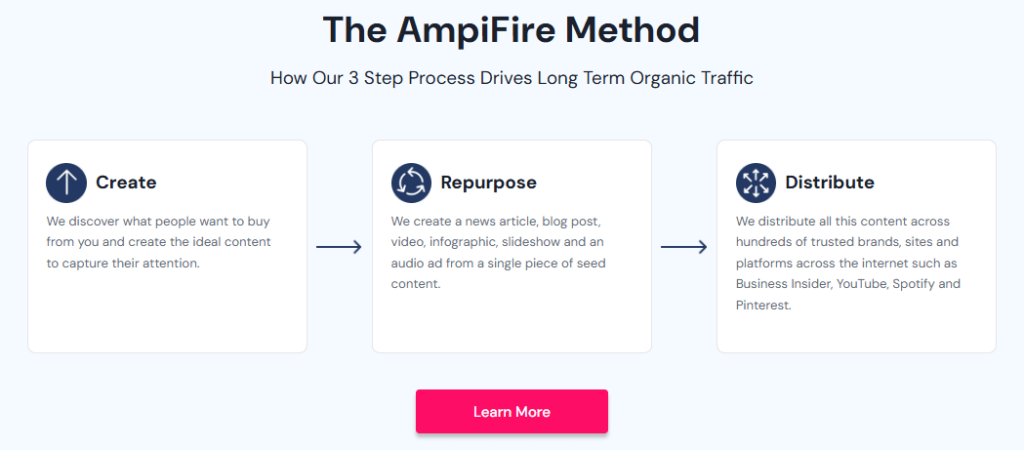Key Takeaways
- Press releases are formal, comprehensive announcements distributed broadly to multiple media outlets, while media pitches are personalized, conversational messages targeting specific journalists with story angles.
- Press releases provide complete information for immediate publication, while media pitches spark curiosity and invite journalists to explore a story further.
- Effective media pitches require research into the journalist’s best and previous work, making them relationship-building tools rather than simple announcements.
- Traditional press releases often get buried within days with minimal results, while multi-format content distribution reaches audiences across search, social media, video, and podcasts for sustained visibility.
- AmpiFire transforms a single topic into 8 different content formats and distributes them across 300+ platforms, delivering ongoing organic traffic far beyond what traditional PR channels can achieve.
Why Traditional PR Tools Are Failing Small Businesses
Most business owners use “press release” and “media pitch” interchangeably without realizing they’re completely different tools meant for different purposes. This misunderstanding costs businesses valuable media opportunities every day.
Send a lengthy press release when a journalist expects a quick, personalized pitch? Your email gets deleted. Send a vague pitch when reporters need complete details? They move on to the next story.
The bigger issue? Even when you use these tools correctly, traditional PR strategies barely move the needle anymore. Journalists receive hundreds of pitches daily, and most press releases never get published. Your carefully crafted announcement disappears into the void, reaching maybe a handful of outlets before being forgotten completely.
Smart businesses are moving beyond this outdated approach by turning one announcement into articles, videos, podcasts, and more—reaching audiences where they actually spend time online.
Why Press Releases Don’t Work Anymore
Smart Businesses Are Moving Beyond Traditional PR
• The Problem: Press releases reach one audience through one channel while your customers are everywhere online. Most get buried within days with poor ROI.
• The Solution: AmpiFire’s AmpCast creates 8 different content formats from one topic and distributes across 300+ high-authority sites including Fox affiliates, Spotify, and YouTube.
What You’ll Learn on PR Zen:
✓ Why multi-channel content delivers 10x better results than press releases
✓ How to amplify your PR efforts across multiple platforms
✓ Real case studies of businesses dominating search, social, video, and podcasts
✓ Cost-effective alternative to expensive PR agencies
Ready to Replace Press Releases? Learn the AmpiFire Method →
Press Release Explained

A press release is your official statement to the world, a complete news story written from a journalist’s perspective, containing every detail a reporter needs to cover your announcement without asking follow-up questions.
These formal documents follow a strict structure: headline, dateline, lead paragraph, supporting details with quotes, company background, and contact information. The tone remains objective and factual, avoiding marketing language.
Press releases answer who, what, when, where, why, and how. You’re essentially writing the article for the journalist, making it easy for them to publish your news with minimal editing.
When Should You Use a Press Release?
Press releases work best for major, time-sensitive announcements:
- Product launches that solve specific problems
- Executive appointments or leadership changes
- Significant partnerships or acquisitions
- Company milestones like funding rounds
- Award wins or significant recognition
- Crisis communication requiring official statements
The keyword is “newsworthy.” Plan distribution one to two weeks before scheduled events to give journalists time to prepare coverage.
Media Pitch Explained
A media pitch is your personal invitation to a journalist, asking them to cover your story. Unlike the comprehensive press release, a pitch is deliberately brief designed to spark curiosity rather than provide every detail.
The tone shifts from formal to conversational. You’re building a relationship, not broadcasting information. Successful pitches feel like one professional reaching out to another with something genuinely valuable to share.
When Should You Use a Media Pitch?
Media pitches excel in situations requiring personalization:
- Securing feature stories or in-depth profiles
- Offering exclusive interviews or early access
- Positioning executives as expert sources
- Following up on previous coverage with new angles
- Suggesting story ideas tied to current events
- Building ongoing relationships with reporters
Pitches work best when you’ve researched the journalist’s recent articles, understand their beat, and tailor your message to their interests.
The 5 Critical Differences Between Press Releases & Media Pitches

Purpose & Scope: Broadcasting vs Targeting
Press releases function as megaphones, broadcasting your news to anyone who’ll listen. You’re casting the widest possible net and hoping the right outlets pick up your story. Media pitches work like precision darts aimed at specific targets. Each pitch gets customized for an individual journalist based on their beat, writing style, and audience.
Content & Detail Level: Complete Story vs Story Hook
A press release contains the entire story. Journalists could copy and paste your release, make minor edits, and publish it as an article. A media pitch provides just enough information to intrigue, not inform completely. You highlight your most compelling angle and deliberately leave journalists wanting more.
Tone & Style: Formal vs Conversational
Press releases maintain journalistic objectivity. You write in third person, avoid exclamation points, and stick to verifiable facts. With media pitches, you can write in first person, use contractions, and let your enthusiasm show through.
Distribution Method: Mass vs Individual
Press releases get distributed through newswires, blasted to media lists, or posted on company newsrooms. You’re publishing your announcement and hoping relevant outlets pick it up. Media pitches go directly to individual journalists via personal email. Each pitch should feel like it was written specifically for that recipient.
Timeline & Shelf Life: Immediate vs Ongoing
Press releases have a short, intense lifespan. They generate coverage within days, if at all. After a week or two, your press release becomes old news. Media pitches can work over longer timeframes. A journalist might receive your pitch, file it away, and reach out weeks later when working on a related story.
Comparison Table: Press Release vs Media Pitch
| Aspect | Press Release | Media Pitch |
| Primary Purpose | Announce news broadly to multiple outlets | Spark a specific journalist’s interest in a story |
| Target Audience | General media, newswires, public | Individual journalists or editors |
| Length | 400–600 words (one page) | 150–250 words (3–4 paragraphs) |
| Tone | Formal, objective, third-person | Conversational, personal, first-person |
| Content Depth | Complete story with all details | Story hook with an intriguing angle |
| Distribution | Mass distribution via newswires, media lists | Direct email to specific journalists |
| Best Use Case | Product launches, company milestones | Feature stories, exclusive interviews |
| Lifespan | Short-term (days to weeks) | Long-term (months later) |
Multi-Format Content Distribution: Advantage over Traditional Press Release

Traditional press releases rely on static text through wire services, limiting engagement and reach. Multi-format content distribution transforms this by packaging information across videos, infographics, podcasts, and social media posts alongside the core message.
This approach captures diverse audiences: executives prefer infographics, while younger demographics prefer video. Multi-format strategies also boost SEO through video content, images, and audio transcripts, creating more indexing opportunities than text alone. Social platforms prioritize visual content, thereby exponentially expanding organic reach.
Engagement times increase dramatically. Traditional releases average 30-second scans, while video or interactive content holds attention for minutes, improving message retention and brand recall.
Platforms like AmpiFire simplify this process by automating the creation and simultaneous distribution of multi-format content across channels. These services handle production, conversion, and placement, turning single announcements into comprehensive campaigns.
AmpiFire: Multi-Format Content that Outperforms Traditional PR

AmpiFire transforms a single core message into eight content formats and distributes them across 300+ high-authority platforms, including NBC and FOX affiliates, YouTube, Spotify, Medium, and SlideShare. When you choose A,mpiFire, you’re not depending on media gatekeepers; you’re reaching audiences directly across multiple channels simultaneously.
The three-step system makes it simple: Research (understanding your business and message), Repurpose (creating eight optimized content formats), and Distribute (publishing across 300+ platforms automatically). You don’t manage any of this; AmpiFire handles everything while you focus on running your business.
Traditional press releases disappear within 24–48 hours, but AmpiFire content lives permanently across the web, building cumulative SEO value and generating organic traffic for months or years. Each format targets different search behaviors and audience preferences.
This diversified approach creates multiple pathways for potential customers to discover your brand, while the interconnected network of backlinks organically boosts your domain authority and search rankings. The result is sustained visibility that grows stronger over time, not a one-day spike that fades immediately.
Real-World Example
Consider a medical device company that switched from traditional press releases to AmpiFire’s multi-format approach. Their eCommerce traffic increased by 300%, generating an initial 51% increase in sales. The difference? Instead of sending announcements to journalists in the hope of coverage, they reached customers directly across search, video, podcasts, and social media with consistent, optimized content.
This was the result of one specific case study. Results vary by industry, competition, and content consistency, but it demonstrates the power of multi-channel distribution over traditional PR methods.
Ready to Replace Press Releases? Learn the AmpiFire Method →
Frequently Asked Questions (FAQs)
Can I write my own press release, or should I hire a professional writer?
Most businesses can write effective press releases in-house by following the standard format and keeping the tone factual rather than promotional. Treat it like a news article, not a marketing brochure. Answer who, what, when, where, why, and how in your opening paragraph, include a relevant quote, and keep it to one page.
For major announcements such as IPOs or crisis communications, professional help ensures proper messaging. But for typical product launches or partnerships, a well-crafted template will serve you well.
How is a journalist the right fit for my media pitch?
Research is everything. Read several recent articles the journalist has written to understand their beat and writing style. Check their social media to see current interests. Look for journalists who’ve covered similar companies or industries, as this means they’re already interested in your topic area.
The right fit means the journalist has recently covered related topics, writes for an audience that would care about your news, and approaches stories in a way that aligns with your announcement.
Should I send a press release or pitch first when I have major news?
Use both strategically. Send targeted media pitches first to journalists you specifically want to cover your story in-depth, offering early or exclusive access. This can secure feature articles and interviews.
Then distribute your press release broadly on the announcement date to reach general media outlets. Think of pitches as targeted rifle shots for high-value coverage, and press releases as your broader net catching additional mentions.
How often should I be sending press releases or pitches to the media?
Quality always trumps quantity. Only reach out when you have genuinely newsworthy information that would interest the journalist’s audience. This might mean three solid press releases per year for major milestones rather than monthly releases about minor updates.
For pitches, you can reach out more frequently if offering different angles or expert commentary, but always ensure each pitch provides real value.
How does AmpiFire help me get better results than traditional press releases and media pitches?
AmpiFire bypasses both problems by transforming your announcement into eight content formats (e.g., news articles, blog posts, infographics, long-form videos, short-form videos, slideshows, podcasts, and social media posts) and distributing them across 300+ platforms where your audience actually finds information.
Your news becomes articles optimized for search, videos appearing in YouTube recommendations, podcast episodes in Spotify libraries, and more.

